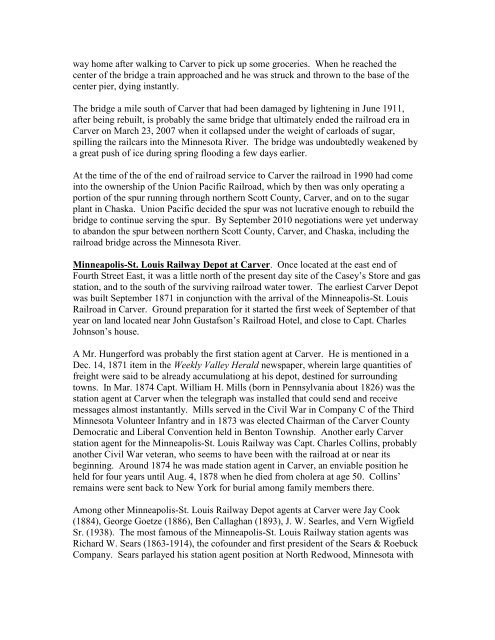Historic Homes and Businesses in Carver - Carver County Historical ...
Historic Homes and Businesses in Carver - Carver County Historical ...
Historic Homes and Businesses in Carver - Carver County Historical ...
You also want an ePaper? Increase the reach of your titles
YUMPU automatically turns print PDFs into web optimized ePapers that Google loves.
way home after walk<strong>in</strong>g to <strong>Carver</strong> to pick up some groceries. When he reached the<br />
center of the bridge a tra<strong>in</strong> approached <strong>and</strong> he was struck <strong>and</strong> thrown to the base of the<br />
center pier, dy<strong>in</strong>g <strong>in</strong>stantly.<br />
The bridge a mile south of <strong>Carver</strong> that had been damaged by lighten<strong>in</strong>g <strong>in</strong> June 1911,<br />
after be<strong>in</strong>g rebuilt, is probably the same bridge that ultimately ended the railroad era <strong>in</strong><br />
<strong>Carver</strong> on March 23, 2007 when it collapsed under the weight of carloads of sugar,<br />
spill<strong>in</strong>g the railcars <strong>in</strong>to the M<strong>in</strong>nesota River. The bridge was undoubtedly weakened by<br />
a great push of ice dur<strong>in</strong>g spr<strong>in</strong>g flood<strong>in</strong>g a few days earlier.<br />
At the time of the of the end of railroad service to <strong>Carver</strong> the railroad <strong>in</strong> 1990 had come<br />
<strong>in</strong>to the ownership of the Union Pacific Railroad, which by then was only operat<strong>in</strong>g a<br />
portion of the spur runn<strong>in</strong>g through northern Scott <strong>County</strong>, <strong>Carver</strong>, <strong>and</strong> on to the sugar<br />
plant <strong>in</strong> Chaska. Union Pacific decided the spur was not lucrative enough to rebuild the<br />
bridge to cont<strong>in</strong>ue serv<strong>in</strong>g the spur. By September 2010 negotiations were yet underway<br />
to ab<strong>and</strong>on the spur between northern Scott <strong>County</strong>, <strong>Carver</strong>, <strong>and</strong> Chaska, <strong>in</strong>clud<strong>in</strong>g the<br />
railroad bridge across the M<strong>in</strong>nesota River.<br />
M<strong>in</strong>neapolis-St. Louis Railway Depot at <strong>Carver</strong>. Once located at the east end of<br />
Fourth Street East, it was a little north of the present day site of the Casey‟s Store <strong>and</strong> gas<br />
station, <strong>and</strong> to the south of the surviv<strong>in</strong>g railroad water tower. The earliest <strong>Carver</strong> Depot<br />
was built September 1871 <strong>in</strong> conjunction with the arrival of the M<strong>in</strong>neapolis-St. Louis<br />
Railroad <strong>in</strong> <strong>Carver</strong>. Ground preparation for it started the first week of September of that<br />
year on l<strong>and</strong> located near John Gustafson‟s Railroad Hotel, <strong>and</strong> close to Capt. Charles<br />
Johnson‟s house.<br />
A Mr. Hungerford was probably the first station agent at <strong>Carver</strong>. He is mentioned <strong>in</strong> a<br />
Dec. 14, 1871 item <strong>in</strong> the Weekly Valley Herald newspaper, where<strong>in</strong> large quantities of<br />
freight were said to be already accumulationg at his depot, dest<strong>in</strong>ed for surround<strong>in</strong>g<br />
towns. In Mar. 1874 Capt. William H. Mills (born <strong>in</strong> Pennsylvania about 1826) was the<br />
station agent at <strong>Carver</strong> when the telegraph was <strong>in</strong>stalled that could send <strong>and</strong> receive<br />
messages almost <strong>in</strong>stantantly. Mills served <strong>in</strong> the Civil War <strong>in</strong> Company C of the Third<br />
M<strong>in</strong>nesota Volunteer Infantry <strong>and</strong> <strong>in</strong> 1873 was elected Chairman of the <strong>Carver</strong> <strong>County</strong><br />
Democratic <strong>and</strong> Liberal Convention held <strong>in</strong> Benton Township. Another early <strong>Carver</strong><br />
station agent for the M<strong>in</strong>neapolis-St. Louis Railway was Capt. Charles Coll<strong>in</strong>s, probably<br />
another Civil War veteran, who seems to have been with the railroad at or near its<br />
beg<strong>in</strong>n<strong>in</strong>g. Around 1874 he was made station agent <strong>in</strong> <strong>Carver</strong>, an enviable position he<br />
held for four years until Aug. 4, 1878 when he died from cholera at age 50. Coll<strong>in</strong>s‟<br />
rema<strong>in</strong>s were sent back to New York for burial among family members there.<br />
Among other M<strong>in</strong>neapolis-St. Louis Railway Depot agents at <strong>Carver</strong> were Jay Cook<br />
(1884), George Goetze (1886), Ben Callaghan (1893), J. W. Searles, <strong>and</strong> Vern Wigfield<br />
Sr. (1938). The most famous of the M<strong>in</strong>neapolis-St. Louis Railway station agents was<br />
Richard W. Sears (1863-1914), the cofounder <strong>and</strong> first president of the Sears & Roebuck<br />
Company. Sears parlayed his station agent position at North Redwood, M<strong>in</strong>nesota with


